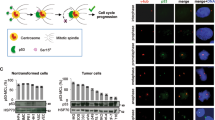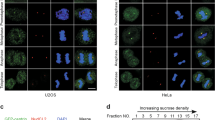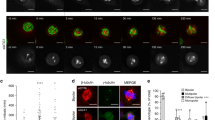Abstract
Abnormal amplification of centrosomes, commonly found in human cancer, is the major cause of mitotic defects and chromosome instability in cancer cells. Like DNA, centrosomes duplicate once in each cell cycle, hence the defect in the mechanism that ensures centrosome duplication to occur once and only once in each cell cycle results in abnormal amplification of centrosomes and mitotic defects. Centrosomes are non-membranous organelles, and undergo dynamic changes in its constituents during the centrosome duplication cycle. Through a comparative mass spectrometric analysis of unduplicated and duplicated centrosomes, we identified mortalin, a member of heat shock protein family, as a protein that associates preferentially with duplicated centrosomes. Further analysis revealed that mortalin localized to centrosomes in late G1 before centrosome duplication, remained at centrosomes during S and G2, and dissociated from centrosomes during mitosis. Overexpression of mortalin overrides the p53-dependent suppression of centrosome duplication, and mortalin-driven centrosome duplication requires physical interaction between mortalin and p53. Moreover, mortalin promotes dissociation of p53 from centrosomes through physical interaction. The p53 mutant that lacks the ability to bind to mortalin remains at centrosomes, and suppresses centrosome duplication in a transactivation function-independent manner. Thus, our present findings not only identify mortalin as an upstream molecule of p53 but also provide evidence for the involvement of centrosomally localized p53 in the regulation of centrosome duplication.
This is a preview of subscription content, access via your institution
Access options
Subscribe to this journal
Receive 50 print issues and online access
$259.00 per year
only $5.18 per issue
Buy this article
- Purchase on Springer Link
- Instant access to full article PDF
Prices may be subject to local taxes which are calculated during checkout







Similar content being viewed by others
References
Agarwal ML, Agarwal A, Taylor WR, Stark GR . (1995). Proc Natl Acad Sci USA 92: 8493–8497.
Blair Zajdel ME, Blair GE . (1988). Oncogene 2: 579–584.
Brown CR, Doxsey SJ, White E, Welch WJ . (1994). J Cell Physiol 160: 47–60.
Brummelkamp TR, Bernards R, Agami R . (2002). Science 296: 550–553.
Ciciarello M, Mangiacasale R, Casenghi M, Zaira Limongi M, D'Angelo M, Soddu S et al. (2001). J Biol Chem 276: 19205–19213.
Crook T, Marston NJ, Sara EA, Vousden KH . (1994). Cell 79: 817–827.
D'Assoro AB, Lingle WL, Salisbury JL . (2002). Oncogene 40: 6146–6153.
Fukasawa K . (2005). Cancer Lett 230: 6–19.
Hadari YR, Haring HU, Zick Y . (1997). J Biol Chem 272: 657–662.
Hinchcliffe EH, Sluder G . (2002). Oncogene 21: 6154–6160.
Hollstein M, Sidransky D, Vogelstein B, Harris CC . (1991). Science 253: 49–53.
Kaul SC, Reddel RR, Mitsui Y, Wadhwa R . (2001). Neoplasia 3: 110–114.
Kaul SC, Taira K, Pereira-Smith OM, Wadhwa R . (2002). Exp Gerontol 37: 1157–1164.
Kawamura K, Izumi H, Ma Z, Ikeda R, Moriyama M, Tanaka T et al. (2004). Cancer Res 64: 4800–4809.
Lange BM, Gull K . (1996). Trends Cell Biol 6: 348–352.
Morris VB, Brammall J, Noble J, Reddel R . (2000). Exp Cell Res 256: 122–130.
Mussman JG, Horn HF, Carroll PE, Okuda M, Tarapore P, Donehower LA et al. (2000). Oncogene 19: 1635–1646.
Oakley BR . (2000). Curr Top Dev Biol 49: 27–54.
Okuda M, Horn HF, Tarapore P, Tokuyama Y, Smulian AG, Chan PK et al. (2000). Cell 103: 127–140.
Ran Q, Wadhwa R, Kawai R, Kaul SC, Sifers RN, Bick RJ et al. (2000). Biochem Biophys Res Commun 275: 174–179.
Scheffner M, Werness BA, Huibregtse JM, Levine AJ, Howley PM . (1990). Cell 63: 1129–1136.
Stewart N, Hicks GG, Paraskevas F, Mowat M . (1995). Oncogene 10: 109–115.
Tarapore P, Fukasawa K . (2002). Oncogene 21: 6234–6240.
Tarapore P, Horn HF, Tokuyama Y, Fukasawa K . (2001a). Oncogene 20: 3173–3184.
Tarapore P, Tokuyama Y, Horn HF, Fukasawa K . (2001b). Oncogene 20: 6851–6863.
Timson J . (1975). Mutat Res 32: 115–132.
Tsujimoto Y . (1998). Genes Cells 3: 697–707.
Wadhwa R, Kaul SC, Mitsui Y, Sugimoto Y . (1993). Exp Cell Res 207: 442–448.
Wadhwa R, Pereira-Smith OM, Reddel RR, Sugimoto Y, Mitsui Y, Kaul SC . (1995). Exp Cell Res 216: 101–106.
Wadhwa R, Takano S, Robert M, Yoshida A, Nomura H, Reddel RR et al. (1998). J Biol Chem 273: 29586–29591.
Wadhwa R, Yaguchi T, Hasan MK, Mitsui Y, Reddel RR, Kaul SC . (2002). Exp Cell Res 274: 246–253.
Acknowledgements
We thank K George for technical assistance. This work was supported in part by National Institute of Health (CA90522 and CA95925).
Author information
Authors and Affiliations
Corresponding author
Rights and permissions
About this article
Cite this article
Ma, Z., Izumi, H., Kanai, M. et al. Mortalin controls centrosome duplication via modulating centrosomal localization of p53. Oncogene 25, 5377–5390 (2006). https://doi.org/10.1038/sj.onc.1209543
Received:
Revised:
Accepted:
Published:
Issue Date:
DOI: https://doi.org/10.1038/sj.onc.1209543
Keywords
This article is cited by
-
GRP75-driven, cell-cycle-dependent macropinocytosis of Tat/pDNA-Ca2+ nanoparticles underlies distinct gene therapy effect in ovarian cancer
Journal of Nanobiotechnology (2022)
-
PSPC1 is a new contextual determinant of aberrant subcellular translocation of oncogenes in tumor progression
Journal of Biomedical Science (2021)
-
p53 mitotic centrosome localization preserves centrosome integrity and works as sensor for the mitotic surveillance pathway
Cell Death & Disease (2019)
-
Relevance of mortalin to cancer cell stemness and cancer therapy
Scientific Reports (2017)
-
A putative N-terminal nuclear export sequence is sufficient for Mps1 nuclear exclusion during interphase
BMC Cell Biology (2015)



